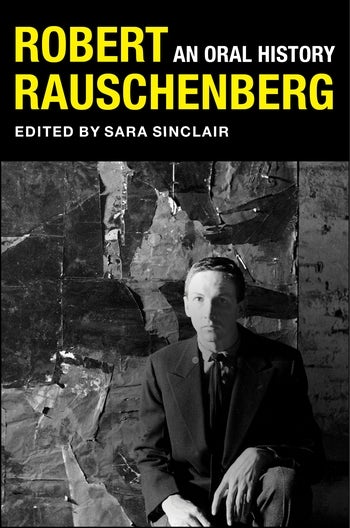Make Your Acquaintance with Robert Rauschenberg!

“Fall in love with Robert Rauschenberg, galactic master of art and life, through his worldwide collaborations.”
~ Dorothy Lichtenstein, president of the Roy Lichtenstein Foundation
Today we are wishing Robert Rauschenberg—one of America’s most influential artists— a happy birthday. Rauschenberg is known for his irreverent and collaborative art. Get to know the man behind the art in this guest post by Sara Sinclair, editor of Robert Rauschenberg: An Oral History, in which she briefly describes his background and work.
Remember to enter this week’s drawing for a chance to win a copy of the book.
• • • • • •
A painter, sculptor, graphic artist, and maker of hybrid forms, Robert Rauschenberg is widely considered one of America’s most influential artists of the twentieth century.
Born Milton Ernest Rauschenberg on October 22, 1925, in Port Arthur, Texas—an oil refinery town on the Gulf of Mexico—Rauschenberg was older brother to Janet and son of Dora Carolina Matson and Ernest Rauschenberg, an employee of Gulf State Utilities. Rauschenberg entered University of Texas at Austin to study pharmacology but left the university because of his difficulty with the coursework (he would later learn he was dyslexic) and his refusal to dissect a frog in biology.

Rauschenberg boating with his parents, Ernest and Dora Rauschenberg, on the bayou near Port Author, Texas, ca 1927. Photograph: Unattributed. Photograph Collection: Robert Rauschenberg Foundation Archives, New York.
After serving in the U.S. Navy as a neuropsychiatric technician, he followed a friend to Kansas City in 1947 to enroll in the Kansa City Art Institute and later studied in Paris and at North Carolina’s Black Mountain College. In 1949, Rauschenberg found his way to New York City, where he lived and worked until 1970.
Working across a wide range of subjects, styles, materials, and techniques, Rauschenberg is credited with foreshadowing every postwar movement since abstract expressionism. However, he never formally associated his work with any of these schools: “At the time that he began making art in the late 1940s and early 1950s, his belief that ‘painting relates to both art and life’ presented a direct challenge to the prevalent modernist aesthetic.”[1]
Rauschenberg’s celebrated “Combines,” begun in the mid-1950s, brought real-world images and objects into the realm of abstract painting and countered sanctioned divisions between painting and sculpture. These works established him as a crucial figure in the transition from abstract expressionism to later modern art movements. As Yvonne Rainer recalled in her oral history,
“I knew very little about post-war American art. Al introduced me to the Cedar Bar and his friends, and I went to openings. I went to what must have been [Rauschenberg’s] first show at the [Leo] Castelli Gallery on East Seventy-seventh Street. I saw the goat [Monogram] and the chicken on the shelf [Satellite]. I nearly rolled on the ground with laughter. It was so refreshing after Abstract Expressionism. He was still an Expressionist using paint in that way, but so irreverent. I think my own sense of humor and irreverence began when I saw that show, and it opened up a whole new set of possibilities.”






